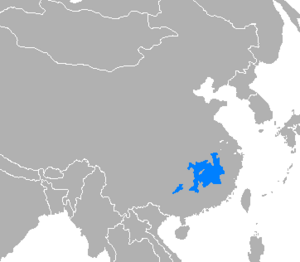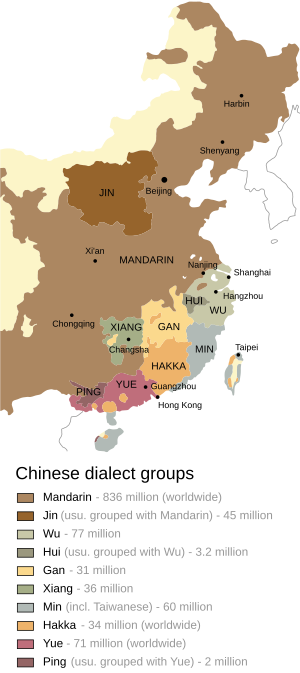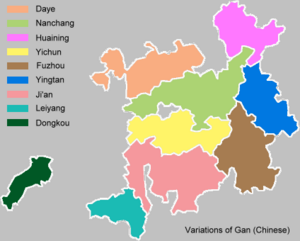Gan Chinese facts for kids
Quick facts for kids Gan |
||||
|---|---|---|---|---|
| Gann 贛語/赣语 Gon ua |
||||

Gan ua (Gan) written in Chinese characters
|
||||
| Native to | China | |||
| Region | central and northern Jiangxi, eastern Hunan, eastern Hubei, southern Anhui, northwest Fujian | |||
| Ethnicity | Gan people | |||
| Native speakers | 22 million (2018) | |||
| Language family |
Sino-Tibetan
|
|||
| Early forms: |
Old Chinese
|
|||
| Writing system | Chinese character Pha̍k-oa-chhi |
|||
| Linguasphere | 79-AAA-f | |||
 |
||||
|
||||
Gan is a group of Sinitic languages. These are languages that belong to the Sino-Tibetan language family. Many people in the Jiangxi province of China speak Gan as their first language. You can also find many Gan speakers in nearby areas. These include Hunan, Hubei, Anhui, and Fujian.
Hakka is the Chinese language most similar to Gan in how it sounds. There are different types of Gan spoken. The Nanchang dialect is considered the most important or "prestige" dialect.
Contents
What is Gan Chinese?
Like other types of Chinese, Gan Chinese is quite different from other varieties. This means speakers of Gan might not easily understand people speaking other Chinese languages. For example, Gan is more similar to Mandarin than to Yue or Min. However, it is even more similar to Xiang than to Mandarin.
Names for the Gan Language
The Gan language has a few different names:
- Gan: This is the most common name. Sometimes it's spelled Gann. This spelling shows how the name sounds in Mandarin. Scholars in mainland China often use "Gan" or "Gan dialect."
- Jiāngxīhuà: This means "Jiangxi language." People often use this name in Chinese. However, the areas where Gan is spoken don't perfectly match the borders of Jiangxi province. So, this name isn't always exact.
- Xi: This is an old name, meaning "right-river language." It's rarely used today. This name came about because most Gan speakers live south of the Yangtze River. This river is on the right side when you travel downstream.
Where is Gan Spoken?
Most Gan speakers live near the Gan River and the Fu River. They also live around Poyang Lake. You can also find many Gan speakers in eastern Hunan and Hubei. Other areas include southern Anhui and northwest Fujian.
About 48 million people speak Gan. Around 29 million of them live in Jiangxi. About 4.5 million are in Anhui, and 5.3 million in Hubei. There are 9 million in Hunan and 270,000 in Fujian.
History of Gan Chinese
Ancient Times
Around 221 BC, during the Qin dynasty, many soldiers moved to southern China. They went to conquer lands in Fujian and Guangdong. Because of this, many Han Chinese people moved to Jiangxi. Later, in the early Han dynasty (202 BC), Nanchang became an important city. It was the capital of the Yuzhang area.
The number of people in Yuzhang grew a lot. It went from 350,000 in AD 2 to 1,670,000 by AD 140. This made it one of the most populated areas in China. During this time, the Gan language slowly started to form.
Middle Ages
China saw a lot of fighting in its central and northern parts. This caused many people to move south to escape the danger. Jiangxi became a stopping point for these travelers. During this time, old Gan started to mix with northern Chinese languages. Even after many years under the Southern Dynasties, Gan kept many of its original features. It also took in some words from northern speech.
By the Tang dynasty, old Gan and the Gan of that time were still very similar. But starting in the Five Dynasties period, people from central and northern Jiangxi began to move. They spread to eastern Hunan, eastern Hubei, southern Anhui, and northwest Fujian. This movement over hundreds of years helped Gan spread to the areas where it is spoken today.
Later Times
Mandarin Chinese became the main standard language in China. This was largely due to political reasons. At the same time, the differences between Gan and Mandarin grew bigger. However, Gan has also been influenced by other nearby languages. These include Jianghuai Mandarin, Xiang, and Hakka. This is especially true in areas where Jiangxi borders these regions.
Modern Times
After 1949, Gan was seen as a "dialect" in Mainland China. It faced a challenging time. The government promoted Mandarin strongly. Today, many young people find it hard to speak Gan well. Some can no longer speak it at all.
However, there is growing interest in protecting local languages. Because of this, Gan has started to appear in local media. You can now find newscasts and TV shows in Gan Chinese.
Gan Languages and Dialects
There are big differences within the Gan-speaking region. Gan is actually made up of many different languages or dialects. For example, in Anfu county, there are two main types called Nanxiang Hua and Baixiang Hua. People from one area might not understand people from the other.
The Language Atlas of China (1987) divides Gan into nine main groups:
| Group | Example Dialect | Provinces | Cities |
|---|---|---|---|
| Changdu 昌都片 | Nanchang dialect | northwestern Jiangxi | Nanchang City, Nangchang, Xinjian, Anyi, Yongxiu, Xiushui*, De'an, Xingzi, Duchang, Hukou, Gao'an*, Fengxin*, Jing'an*, Wuning*, Tonggu* |
| northeastern Hunan | Pingjiang | ||
| Yiliu 宜浏片 / 宜瀏片 | Yichun dialect | central and western Jiangxi | Yichun City, Yichun, Yifeng*, Shanggao, Qingjiang, Xingan, Xinyu City, Fen yi, Pingxiang City, Fengcheng, Wanzai |
| eastern Hunan | Liuyang*, Liling | ||
| Jicha 吉茶片 | Ji'an dialect | central and southern Jiangxi | Ji'an City, Ji'an*, Jishui, Xiajiang, Taihe*, Yongfeng*, Anfu, Lianhua, Yongxin*, Ninggang*, Jianggangshan* Wan'an, Suichuan* |
| eastern Hunan | Youxian*, Chaling*, Linxian | ||
| Fuguang 抚广片 / 撫廣片 | Fuzhou dialect (撫州, not to be confused with 福州) | central and eastern Jiangxi | Fuzhou City, Linchuan, Chongren, Yihuang, Le'an, Nancheng, Lichuan, Zixi, Jinxi, Dongxiang, Jinxian, Nanfeng, Guangchang* |
| southwestern Fujian | Jianning, Taining | ||
| Yingyi 鹰弋片 | Yingtan dialect | northeastern Jiangxi | Yingtan City, Guixi, Yujiang, Wannian, Leping, Jingdezhen*, Yugan, Poyang, Pengze, Hengfeng, Yiyang, Chuanshan |
| Datong 大通片 | Daye dialect | southeastern Hubei | Daye, Xianning City, Jiayu, Puqi, Chongyang, Tongcheng, Tongshan, Yangxin, Jianli* |
| eastern Hunan | Linxiang*, Yueyang*, Huarong | ||
| Leizi 耒资片 / 耒資片 | Leiyang dialect | eastern Hunan | Leiyang, Changning, Anren, Yongxing, Zixing City |
| Dongsui 洞绥片 / 洞綏片 | Dongkou dialect | southwestern Hunan | Dongkou*, Suining*, Longhui* |
| Huaiyue 怀岳片 / 懷嶽片 | Huaining dialect | southwestern Anhui | Huaining, Yuexi, Qianshan, Taihu, Wangjiang*, Susong*, Dongzhi*, Shitai*, Guichi* |
Cities marked with * are partly Gan-speaking.
How Gan Grammar Works
Gan grammar is similar to other southern Chinese languages. Usually, sentences follow a "subject–verb–object" order. For example, "I hold you" would be ngo tsot dok ň.
However, you can also change the order using special words.
- Ngo lat ň tsot dok means "I take you and hold."
- Ň den ngo tsot dok means "You are held by me." This is like saying "You allow yourself to be held by me."
Special Gan Words
Gan has many old words and phrases from ancient Chinese. These words are often not used in Mandarin anymore. For example:
- In Gan, "clothes" is 衣裳, but in Mandarin it's 衣服.
- To "sleep" in Gan is 睏覺, while in Mandarin it's 睡覺.
Gan speakers also use special words called interjections. These are words like 哈, 噻, and 啵. They help to show different feelings and make sentences stronger. For example, 下里巴人 is a Gan phrase to describe something dirty. It comes from an old song from the Chu region in ancient China.
How Gan is Written
Gan is written using Chinese characters. However, it doesn't have a long history of being written down. There are also some ways to write Gan using the Roman alphabet, but these are not widely used. When Gan speakers write, they usually use written vernacular Chinese. This is the common written style used by all Chinese speakers.
See also
 In Spanish: Chino gan para niños
In Spanish: Chino gan para niños



